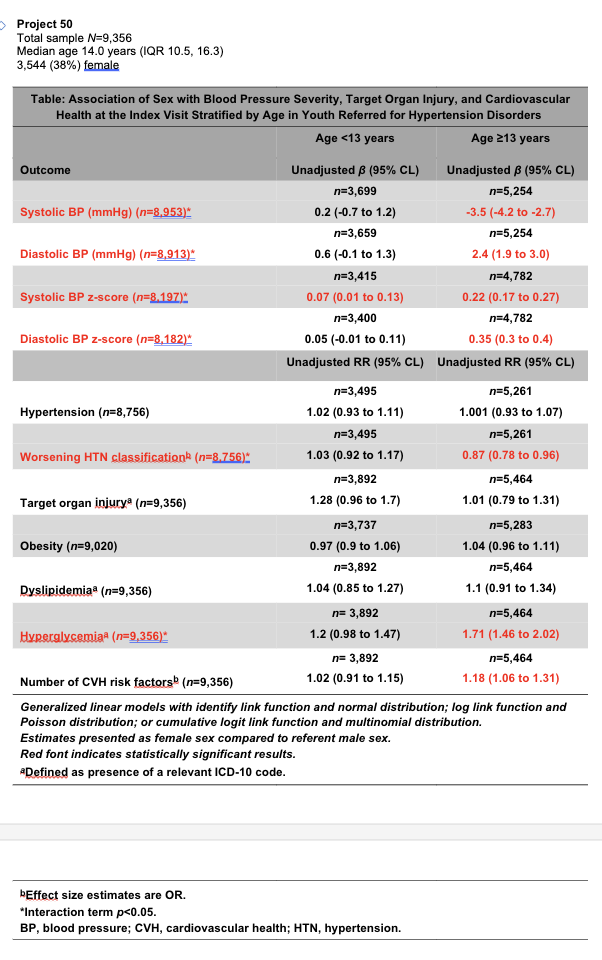Hypertension
Session: Hypertension
037 - Association of Sex with Blood Pressure Severity and Cardiovascular Health by Age at Baseline in Youth Receiving Subspecialty Care for Hypertension Disorders: A SUPERHERO Analysis
Saturday, April 26, 2025
2:30pm - 4:45pm HST
Publication Number: 37.3975
Penelope C. Mewborn, Wake Forest School of Medicine of Wake Forest Baptist Medical Center, Winston-Salem, NC, United States; Melissa Medina, Wake Forest School of Medicine of Wake Forest Baptist Medical Center, Winston-Salem, NC, United States; Aleya Monsalve, Wake Forest School of Medicine of Wake Forest Baptist Medical Center, Winston-Salem, NC, United States; Lauren Nicole. Spease, Wake Forest School of Medicine of Wake Forest Baptist Medical Center, High Point, NC, United States; Andrew M. South, Wake Forest School of Medicine of Wake Forest Baptist Medical Center, Winston Salem, NC, United States; Josephine G. Yost, Wake Forest School of Medicine of Wake Forest Baptist Medical Center, Winston-Salem, NC, United States; Jemima E. Piloso, Wake Forest School of Medicine of Wake Forest Baptist Medical Center, Winston-Salem, NC, United States; Olivia Smith, Wake Forest School of Medicine of Wake Forst Baptist Medical Center, Winston-Salem, NC, United States; Sheridan Lee, Wake Forest School of Medicine of Wake Forest Baptist Medical Center, Winston Salem, NC, United States; Margaret Murphy, University of Kentucky College of Medicine, Lexington, KY, United States

Penelope C. Mewborn, B.S.P.H. (she/her/hers)
Graduate Student
Wake Forest School of Medicine of Wake Forest Baptist Medical Center
Winston-Salem, North Carolina, United States
Presenting Author(s)
Background: Hypertension (HTN) is increasingly common in adults and youth and increases the risk for cardiovascular disease. Despite extensive research demonstrating sex and age disparities in HTN severity in adults, data is lacking in youth.
Objective: Determine if age modifies the strength of the association of sex with BP severity, target organ injury (TOI), and cardiovascular health in youth with HTN disorders at baseline.
Design/Methods: Cross-sectional inferential analysis of baseline data from 7 sites in the Study of the Epidemiology of Pediatric Hypertension (SUPERHERO), a retrospective Registry of electronic health record data. Data was acquired using standardized biomedical informatics scripts and validated by randomly selected manual record review. Inclusion criteria were youth < 19 years old who received care from subspecialists for HTN disorders from 1/1/2016–12/31/2023 defined by ICD-10 codes. Exclusion criteria were kidney failure on dialysis, kidney transplantation, or pregnancy by ICD-10 codes. The exposure was sex, the effect modifier was age defined by < 13 years or ≥ 13 years. We used unadjusted generalized linear models to estimate the association of sex with the outcomes BP severity with z-scores and classification per US guidelines, obesity by BMI or weight-for-length percentiles, and TOI, dyslipidemia, and hyperglycemia by ICD-10 codes.
Results: Of 9,356 participants, 38% were female and median age was 14.0 years (IQR 10.5, 16.3). We observed statistically significant effect modification by age for BP and hyperglycemia (Table). Except for systolic BP, adolescent female participants had a greater BP than males (e.g., 2.4-mmHg higher diastolic BP (95% CL 1.9 to 3.0). However, adolescent females had 13% lower odds of having worsening HTN (95% CL 0.79 to 0.96) vs. males. Adolescent females had a 71% higher risk of hyperglycemia vs. males (95% CL 1.46 to 2.02).
Conclusion(s): In this analysis of baseline data from youth with HTN disorders, we observed that adolescent females had higher BP on average but less severe HTN than adolescent males as well as greater hyperglycemia risk. Ongoing steps in SUPERHERO include multivariable modeling and improved case definitions. Future directions include sponsoring programs to educate parents and youth to watch for high BP readings during adolescence. Our findings bring awareness to medical training so that future providers are alert for the clinical signs of adolescent HTN. If confirmed and validated, our findings could lead to a decrease in adolescents developing early health complications such as heart disease and strokes, improving overall health for youth.
Results


